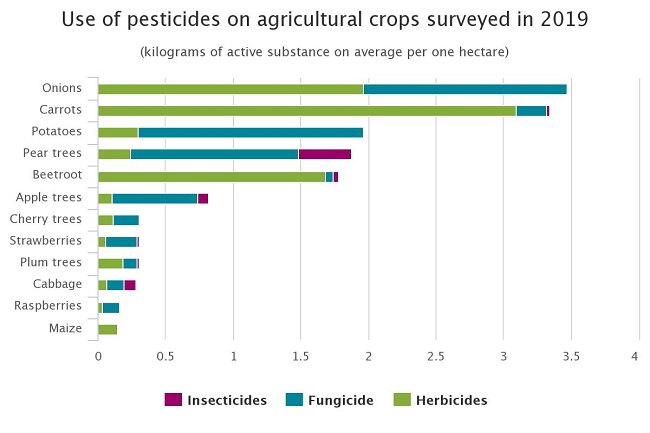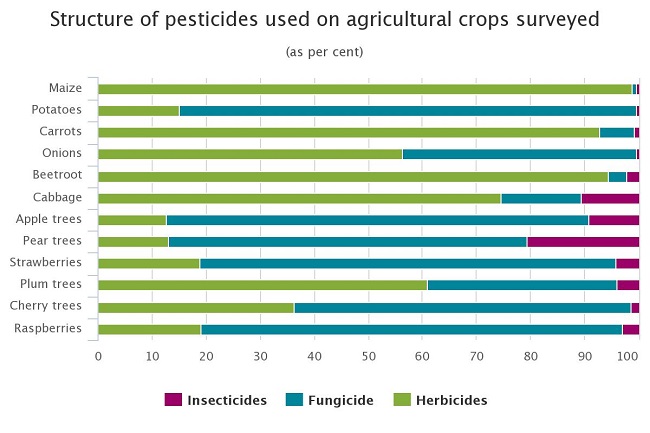Agriculture, Analytics, Ecology, Latvia, Markets and Companies
International Internet Magazine. Baltic States news & analytics
Tuesday, 18.11.2025, 04:30
Latvia: The volume of pesticides used on strawberry areas in 2019 was by 86% lower than 5 years ago
 Print version
Print versionThe volume of pesticides used on apple trees per one hectare of plantation decreased from 1.28 kg in 2014 to 0.82 kg in 2019 or by 36%, for cherry plantations – from 1.28 kg to 0.31 kg or by 76%, respectively, for plum plantations – from 0.83 kg to 0.30 kg or by 63%, for pear plantations - from 2.18 kg to 1.87 kg or by 14%, for raspberry plantations - from 0.44 kg to 0.16 kg or by 63%, but for strawberry areas - from 0.44 kg to 0.06 kg or by 86%.
23% of plum areas, 25% of raspberry plantations, 30% of apple plantations, 31% of cherry plantations, 36% of strawberry areas and 56% of pear plantations were treated with pesticides in 2019.
“Depending on the weather, the use of pesticides varies from year to year. Various pests develop more under dry weather conditions, which are then controlled by insecticides, whereas when humidity is high, both the disease and weed populations develop, which are controlled by fungicides and herbicides, respectively. The weather was relatively dry in 2019 - especially spring and the first half of the summer, therefore diseases developed less and fungicides were rarely used to control them, but in some fields they did not need to be used at all,“ Vents Ezers, Director of the Plant Protection Department of the State Plant Protection Service, emphasizes.
The volume of pesticides used on carrot areas, beetroot areas and onion areas has increased, but the volume used on cabbage areas has decreased
In open field vegetable areas, the volume of pesticides used per one hectare of crops and plantations has increased for carrot areas, beetroot areas and onion areas, but decreased for cabbage areas. The volume of pesticides used per one hectare of carrot area increased from 2.09 kg in 2014 to 3.34 kg in 2019 or by 60%, on onion areas - from 3.03 kg to 3.49 kg or by 15%, respectively, but on beetroot areas - from 0.70 kg to 1.78 kg or by 153%.
The volume of pesticides used per one hectare of cabbage areas decreased from 1.01 kg in 2014 to 0.86 kg in 2019 or by 15%, but in potato plantations from 2.05 kg to 2.00 kg or by 2.4%, respectively.
In 2019, 87% of cabbage areas, 89% of onion areas, 90% of carrot and beetroot areas were treated with pesticides, mainly herbicides, for weed control. Pesticides were used in 67% of potato areas.

The increase of the volume of pesticides is affected by increase in the use of herbicides for certain vegetable crops
The increase of the volume of pesticides used per one hectare of carrot areas was affected by increase in the use of herbicides on carrot areas from 1.83 kg in 2014 to 3.10 kg in 2019 or by 69%, on beetroot areas- from 0.69 kg to 1.68 kg or by 143% respectively, and on onion areas - from 1.15 kg to 1.96 kg or by 70%.
'The increase in herbicide use can be explained by seasonal differences in different years, which affect the range of herbicides used. Effective weed control in vegetable areas is a key condition for successful harvesting. The decision on the choice of a particular type of herbicide depends on the stage of development of the crop as well as the weather conditions. Dry weather conditions in 2019 necessitated the use of herbicides after crop germination, such as prosulfocarb and metamitron, the consumption of which was relatively higher per one hectare,” Vents Ezers explains.

Fungicides were mostly used on apple and raspberry plantations
Fungicides were mostly used on apple and raspberry plantations in 2019 – 78% of the total volume of pesticides used on both apple and raspberry plantations; on pear plantations 66 %, on cherry plantations – 62%, on strawberry areas – 77%, and potato plantations – 84% respectively.
In turn, herbicides for weed control were mostly used on beetroot areas – 94% of the total volume of pesticides used on beetroot areas, on carrot areas 93%, on cabbage areas – 75%, and on onion areas – 56% respectively.
Insecticides were used in a very small volume last year
Insecticides were used in a very small volume last year - only 21% of the pesticides used in pear plantations and 11 % of the pesticides used in cabbage areas were insecticides.
The volume of pesticides used on crops is also affected by use of pesticides containing heavier active substances. Three herbicide active substances - aclonifen, pendimethalin and prosulfocarb - accounted for 85% of all pesticides that were used to control weeds in carrot areas in 2019.
In beetroot areas, 48% of the total volume of pesticides used was made up of one herbicide active substance - metamitron, the use of which per hectare of beetroot increased from 0.93 kg in 2014 to 1.49 kg in 2019 or by 60%.
87% of the total volume of pesticides used in onion areas consisted of active substances: aclonifen, pendimethalin and fungicide, which provide plant protection against fungal diseases - mancozeb.
- 28.01.2022 BONO aims at a billion!
- 25.01.2021 Как банкиры 90-х делили «золотую милю» в Юрмале
- 30.12.2020 Накануне 25-летия Балтийский курс/The Baltic Course уходит с рынка деловых СМИ
- 30.12.2020 On the verge of its 25th anniversary, The Baltic Course leaves business media market
- 30.12.2020 Business Education Plus предлагает анонсы бизнес-обучений в январе-феврале 2021 года
- 30.12.2020 Hotels showing strong interest in providing self-isolation service
- 30.12.2020 EU to buy additional 100 mln doses of coronavirus vaccine
- 30.12.2020 ЕС закупит 100 млн. дополнительных доз вакцины Biontech и Pfizer
- 29.12.2020 В Rietumu и в этот раз создали особые праздничные открытки и календари 2021
- 29.12.2020 Latvia to impose curfew, state of emergency to be extended until February 7








 «The Baltic Course» Is Sold and Stays in Business!
«The Baltic Course» Is Sold and Stays in Business!

